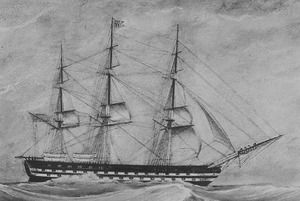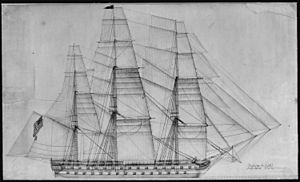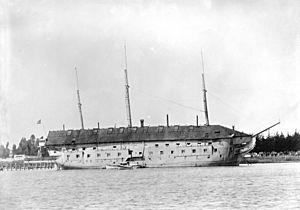USS Independence (1814) facts for kids
 |
|
Quick facts for kids History |
|
|---|---|
| Name | USS Independence |
| Namesake | Declaration of Independence |
| Builder | Boston Navy Yard |
| Launched | 22 June 1814 |
| Decommissioned | 1822 |
| Refit | Razeed, 1836 |
| Recommissioned | 26 March 1837 |
| Decommissioned | 3 November 1912 |
| Stricken | 3 September 1913 |
| Fate | Scrapped 1915 |
| General characteristics | |
| Type | Ship of the line |
| Tonnage | 2243 |
| Length | 190 ft 9 in (58.14 m) |
| Beam | 54 ft 7 in (16.64 m) |
| Draft | 21 ft 3 in (6.48 m) |
| Propulsion | Sail |
| Complement | 790 officers and enlisted |
| Armament | 90 × 32-pounder (15 kg) guns |
The USS Independence was a very important ship in the early United States Navy. It was a large wooden ship with three masts, meaning it used sails to move. Originally, it was a "ship of the line," which was a powerful warship with many cannons. It was the very first ship of this type to join the U.S. Navy. Later, in 1836, it was changed into a smaller, faster ship called a "frigate."
Contents
The Story of USS Independence
Early Years and First Mission
The Independence was built and launched on June 22, 1814, at the Boston Navy Yard. Right away, it was fitted with cannons and stayed in Boston with another famous ship, the USS Constitution. They couldn't leave port because British warships were blocking them during the War of 1812.
After the war ended, the Independence set sail on July 3, 1815. It was the lead ship for Commodore William Bainbridge. Their mission was to stop pirates from the Barbary Coast who were attacking American merchant ships.
By the time Independence reached the Mediterranean Sea, another American fleet had already made peace with the pirates. However, the Independence still sailed around the Barbary ports. This impressive show of American naval power helped make sure the peace treaties were followed. After showing the world the growing strength of the U.S. Navy, Independence returned home on November 15, 1815. It stayed in Boston as a flagship, which means it was the main ship for important commanders, until 1822 when it was put "in ordinary" (meaning it was taken out of active service).
Big Changes: The 1836 Refit
Independence stayed out of service in Boston until 1836. That year, it went through a major change. It was "razeed," which means one of its decks was removed. This made it smaller and faster. It was then re-classified as a 54-gun frigate, even though it was still a very large and powerful one. It became known as one of the fastest and strongest frigates in the Navy.
Journeys to Russia and South America
The Independence was put back into service on March 26, 1837. It left Boston on May 20, 1837, as the flagship for Commodore John B. Nicholson. On board was George M. Dallas, who was going to be the U.S. Minister to Russia. The ship made a record-breaking trip across the Atlantic Ocean to England.
After visiting England and Denmark, it arrived in Kronstadt, Russia, on July 29, 1837. The Emperor of Russia, Nicholas I of Russia, even visited the ship! Two days later, Mr. Dallas and his family went to Saint Petersburg.
After being treated very well by the Russian government, Independence left Russia on August 13, 1837. It then sailed to Rio de Janeiro, Brazil. There, it became the flagship for the Brazil Squadron. Its job was to protect American trade ships along the eastern coast of South America.
This duty continued until 1839. Commodore Nicholson even tried to help end a war between France and Argentina. He wanted to restore peace so that trade could continue normally. Independence returned to New York City on March 30, 1840. It was then put "in ordinary" again until May 14, 1842. After that, it became the flagship for Commodore Charles Stewart in the Home Squadron, based in Boston and New York, until December 3, 1845.
The Mexican War and Pacific Adventures
The Independence was recommissioned on August 4, 1846. The United States was already at war with Mexico. The ship left Boston on August 29, 1846, heading for the coast of California. It arrived in Monterey Bay on January 22, 1847, and became the flagship for Commodore William Shubrick, who commanded the Pacific Squadron.
The Independence helped block Mexican ports. It captured a Mexican ship called Correo and a small boat on May 16, 1847. It also helped capture Guaymas on October 19 and sent sailors and Marines ashore to take Mazatlán on November 11, 1847.
Later, it sailed as far as Hawaii, visiting Hilo, Lahaina, and Honolulu in August and September 1848. Independence returned to the East Coast at Norfolk, Virginia, on May 23, 1849, and was decommissioned there on May 30.
Final Years and Retirement
The Independence was put back into service on July 7, 1849. It left Norfolk on July 26 under Captain Thomas Conover. Its mission was to be the flagship for the Mediterranean Squadron. It was the first U.S. warship to visit La Spezia, Italy, arriving on May 23, 1850, to a very warm welcome. It returned to Norfolk on June 25, 1852, and was put "in ordinary" in New York on July 3, 1852.
Independence was recommissioned in September 1854 and left New York on October 10. It became the flagship for the Pacific Squadron, sailing under Commodore William Mervine. It arrived in Valparaíso, Chile, on February 2, 1855. Its travels took it north to San Francisco and west to Hawaii.
On October 2, 1857, it entered the Mare Island Naval Shipyard. From then on, it served as a "receiving ship," which means it was used as a floating barracks or office for new sailors joining the Navy. It stayed in this role for a very long time, until it was officially decommissioned on November 3, 1912. Its name was removed from the Navy's list of ships on September 3, 1913.
The End of a Long Journey
The Independence finally left the Mare Island Navy Yard on November 28, 1914. It was sold to a person named John H. Rinder and towed to the Union Iron Works in San Francisco. There were plans to turn it into a restaurant for a big event called the Panama–Pacific International Exposition, but this never happened.
Instead, valuable parts like heavy iron and strong wood were taken from the ship. On the night of September 20, 1915, the Independence was burned on the mud flats at Hunters Point. This was done to get back its metal parts. It was a sad end for a ship that had served the U.S. Navy for over a century.




